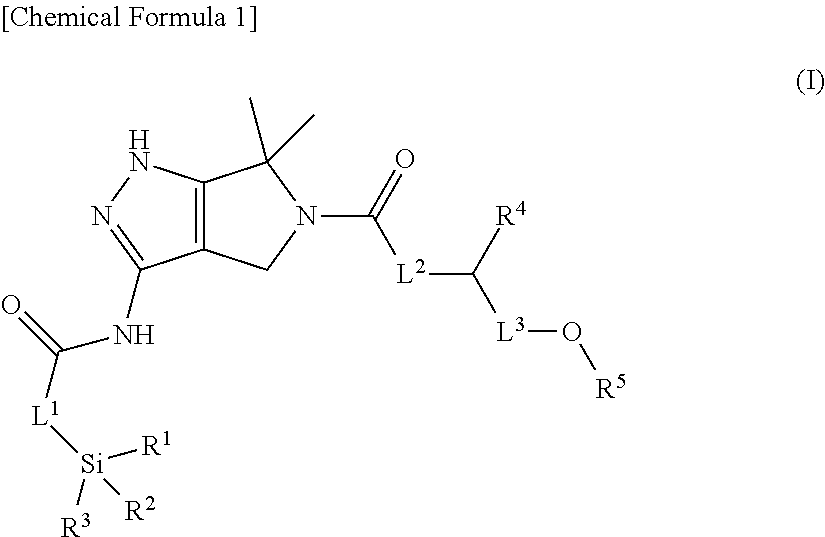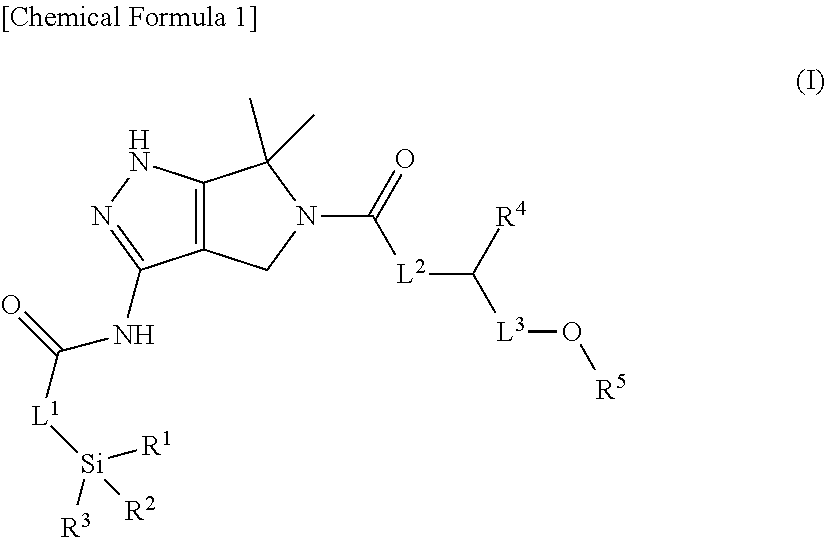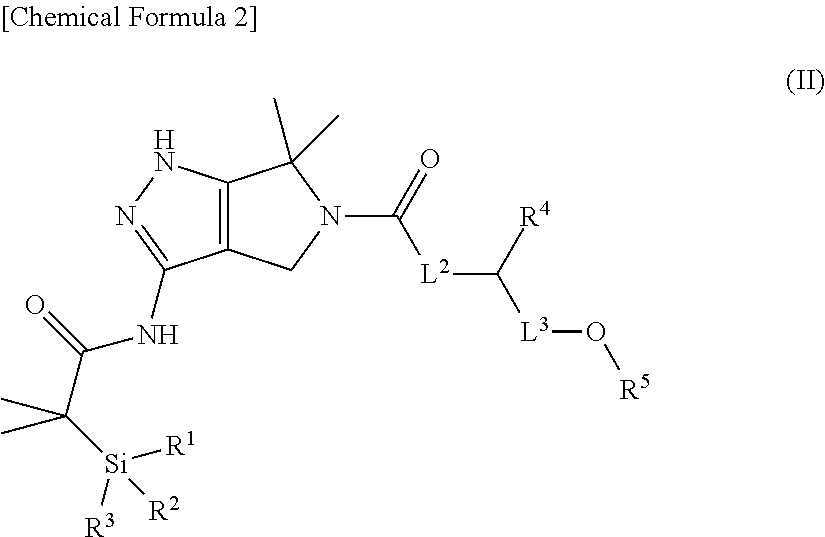Substituted dihydropyrrolopyrazole compound
- Summary
- Abstract
- Description
- Claims
- Application Information
AI Technical Summary
Benefits of technology
Problems solved by technology
Method used
Image
Examples
example 1
(S)—N-(2-Hydroxy-1-phenylethyl)-6,6-dimethyl-3-[1-(trimethylsilyl)cyclobutanecarboxamido]-4,6-dihydropyrrolo[3,4-c]pyrazole-5(1H)-carboxamide (Compound No. IV-114)
[0592]
[0593]To a solution of 308 mg (0.698 mmol) of ethyl 5-(chlorocarbonyl)-6,6-dimethyl-3-[1-(trimethylsilyl)cyclobutanecarboxamido]-5,6-dihydropyrrolo[3,4-c]pyrazole-2(4H)-carboxylate synthesized in the similar manner as in Reference Example 3 in 6 ml of THF, 0.23 ml (1.4 mmol) of DIPEA and 472 mg (3.44 mmol) of (S)-(+)-2-phenylglycinol were added at room temperature, then applied to a microwave reaction apparatus, and reacted at 80° C. for 1 hour. Subsequently, 2.7 ml (67 mmol) of methanol and 2.7 ml (19 mmol) of triethylamine were added to the reaction solution, then applied to a microwave reaction apparatus, and reacted at 80° C. for 0.5 hours.
[0594]After the completion of the reaction, the reaction solution was concentrated under reduced pressure. The obtained concentration residue was subjected to silica gel column...
example 2
(S)—N-(2-Hydroxy-1-phenylethyl)-6,6-dimethyl-3-[1-(trimethylsilyl)cyclopropanecarboxamido]-4,6-dihydropyrrolo[3,4-c]pyrazole-5(1H)-carboxamide (Compound No. 111-114)
[0597]
[0598]To a solution of 433 mg (1.08 mmol) of ethyl 6,6-dimethyl-3-[1-(trimethylsilyl)cyclopropanecarboxamido]-5,6-dihydropyrrolo[3,4-c]pyrazole-2(4H)-carboxylate hydrochloride synthesized in the similar manner as in Reference Example 7 in 7.5 ml of dehydrated dichloromethane, 0.90 ml (5.2 mmol) of DIPEA was added at room temperature in a nitrogen atmosphere, and then, a solution of 275 mg (0.928 mmol) of bis(trichloromethyl)carbonate in 2.5 ml of dehydrated dichloromethane was added dropwise at −78° C. and stirred at the same temperature as above for 2.5 hours.
[0599]After the completion of the reaction, 10 ml of a saturated aqueous solution of sodium bicarbonate was added to the reaction solution and stirred while the temperature was raised to room temperature for a while. The organic layer and the aqueous layer we...
example 3
(S)—N-(2-Hydroxy-1-phenylethyl)-6,6-dimethyl-3-[2-methyl-2-(trimethylsilyl)propanamido]-4,6-dihydropyrrolo[3,4-c]pyrazole-5(1H)-carboxamide (Compound No. 11-114)
[0604]
[0605]To a solution of 337 mg (0.714 mmol) of 5-tert-butyl 1-ethyl 6,6-dimethyl-3-[2-methyl-2-(trimethylsilyl)propanamido]pyrrolo[3,4-c]pyrazole-1,5(4H,6H)-dicarboxylate synthesized in the similar manner as in Reference Example 9 in 3 ml of dehydrated dichloromethane, 0.25 ml (2.2 mmol) of 2,6-lutidine and 0.39 ml (2.2 mmol) of trimethylsilyl trifluoromethanesulfonate were added in this order at 0° C. in a nitrogen atmosphere and stirred at the same temperature as above for 1.5 hours.
[0606]After the completion of the reaction, the reaction solution was diluted with dichloromethane and subsequently washed with a saturated aqueous solution of sodium bicarbonate. The organic layer and the aqueous layer were separated, and then, the aqueous layer was subjected to extraction with dichloromethane twice. All of the obtained o...
PUM
 Login to View More
Login to View More Abstract
Description
Claims
Application Information
 Login to View More
Login to View More - R&D
- Intellectual Property
- Life Sciences
- Materials
- Tech Scout
- Unparalleled Data Quality
- Higher Quality Content
- 60% Fewer Hallucinations
Browse by: Latest US Patents, China's latest patents, Technical Efficacy Thesaurus, Application Domain, Technology Topic, Popular Technical Reports.
© 2025 PatSnap. All rights reserved.Legal|Privacy policy|Modern Slavery Act Transparency Statement|Sitemap|About US| Contact US: help@patsnap.com



